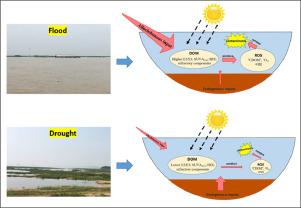Water Research ( IF 11.4 ) Pub Date : 2022-09-19 , DOI: 10.1016/j.watres.2022.119136 Na Song 1 , Dinggui Wu 2 , Huacheng Xu 1 , Helong Jiang 1

|
Reactive oxygen species (ROS) are omnipresent in natural aquatic environments, and play an important role in biogeochemical cycles. One of the dominant sources of ROS in surface waters was thought to be from dissolved organic matter (DOM) interacting with photochemical process. The properties of DOM were different between the flood and drought periods in lakes; yet, information on how these variations influence ROS photoproduction is unknown. Through a three-year study, the photochemical properties of DOM and the resultant ROS photoproduction between the flood and drought period were determined in the largest freshwater lake in China (Lake Poyang). Results found that quantum yield coefficients of excited triplets (3CDOM*), apparent quantum yields of singlet oxygen (1O2) and hydroxyl radicals (•OH) were holistically higher in the flood period than those in the drought period. The optical properties of DOM showed that DOM in the flood period featured an allochthonous input, accompanied by higher molecular size (E2/E3), aromatic content (SUVA254), humification degree (HIX), while DOM in the drought period was mainly internal input. Fourier transform ion cyclotron resonance mass spectrometry (FI-ICR MS) further revealed that some refractory components, such as lignin-like and carboxyl-rich alicyclic molecules (CRAM) presented higher abundance in the flood period, and played the positive impacts on ROS production. Orthogonal partial least squares (OPLS) were used to build novel multivariate predictive models for indicating the spatio-temporal ROS production. Also, the relatively higher steady-state concentrations of 3CDOM* and 1O2 in the flood period could significantly diminish the half-lives of acetochlor. Considering the photochemical activity of DOM varied considerably at different periods, this study provided a new method to predict ROS production and contributed to a new insight into stage-specific emerging contaminants removing in natural aquatic environments.
中文翻译:

洪旱交替条件下某大湖活性氧(ROS)生产特征综合评价
活性氧(ROS)在天然水生环境中无处不在,在生物地球化学循环中发挥着重要作用。地表水中 ROS 的主要来源之一被认为来自与光化学过程相互作用的溶解有机物 (DOM)。汛期和旱期湖泊DOM的性质不同;然而,关于这些变化如何影响 ROS 光产生的信息尚不清楚。通过为期三年的研究,在中国最大的淡水湖(鄱阳湖)中确定了 DOM 的光化学性质以及洪水和干旱期间由此产生的 ROS 光生产。结果发现激发三重态的量子产率( 3 CDOM*)、单线态氧的表观量子产率( 1 O 2)和羟基自由基(•OH)在洪水期总体上高于干旱期。DOM的光学特性表明,洪水期DOM具有异地输入,伴随着更高的分子尺寸(E2/E3),芳香族含量(SUVA 254)、腐殖化度(HIX),而干旱期的 DOM 主要是内部输入。傅里叶变换离子回旋共振质谱(FI-ICR MS)进一步揭示了一些耐火组分,如类木质素和富含羧基的脂环分子(CRAM)在洪水期的丰度较高,对活性氧的产生起到了积极的影响。 . 正交偏最小二乘法 (OPLS) 用于构建新的多变量预测模型,以指示时空 ROS 的产生。此外,相对较高的稳态浓度3 CDOM* 和1 O 2在汛期可显着缩短乙草胺的半衰期。考虑到 DOM 的光化学活性在不同时期有很大差异,本研究提供了一种预测 ROS 产生的新方法,并有助于对天然水生环境中特定阶段新兴污染物的去除有了新的认识。











































 京公网安备 11010802027423号
京公网安备 11010802027423号